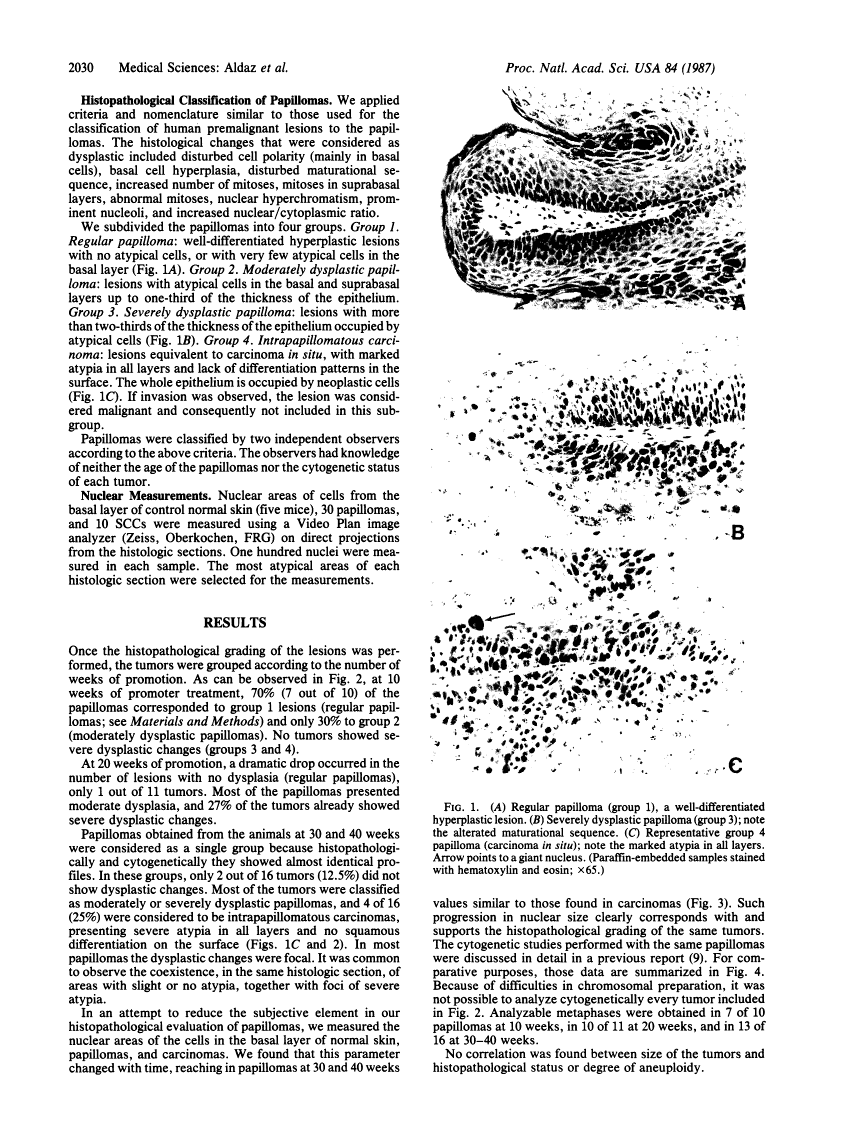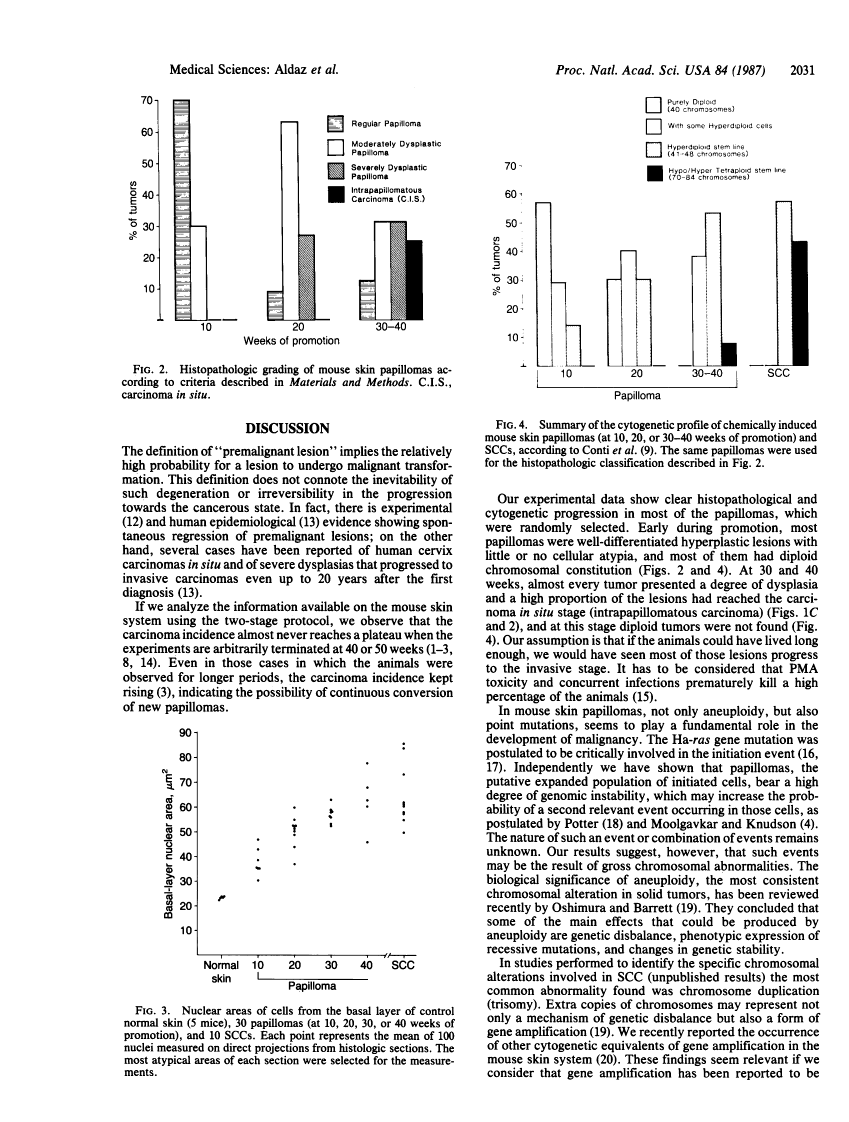Abstract
Free full text

Progressive dysplasia and aneuploidy are hallmarks of mouse skin papillomas: relevance to malignancy.
Abstract
We report a systematic histopathologic study of papillomas at different times during promotion, correlating the results with those from cytogenetic analysis of the same tumors. Papillomas were induced in SENCAR mice by two-stage carcinogenesis (7,12-dimethylbenz[a]anthracene and phorbol 12-myristate 13-acetate). Individual tumors were randomly sampled at different times during promotion, and histopathologic and cytogenetic studies were carried out on every tumor. Early during promotion (10 weeks), most papillomas were well-differentiated hyperplastic lesions with mild or no cellular atypia. No tumors showed severe dysplastic changes. By 20 weeks of promotion, a dramatic drop had occurred in the number of lesions with no dysplasia. Most of the tumors presented moderate dysplasia, and some already showed severe dysplastic changes. At later stages (30-40 weeks), most of the papillomas were classified as moderately or severely dysplastic papillomas, and several were considered to be intrapapillomatous carcinomas. This histopathologic evaluation was supported by nuclear measurements performed on papillomas at different time points. Chromosomal abnormalities followed a similar trend. Papillomas seem to start as diploid lesions, but between 10 and 20 weeks of promotion, hyperdiploid cells can be observed in almost every tumor. In some cases the stem line was taken over by aneuploid clones. At 40 weeks of promotion, all papillomas were aneuploid, most of them with hyperdiploid stem lines. A positive correlation was found between the histological and cytogenetic studies, with the most aggressive and atypical tumors being the more aneuploid. These results support the idea that most, if not all, papillomas are truly premalignant lesions in different stages of the potential progression toward malignancy. Chromosomal abnormalities might play an important role in the sequence of events leading to malignancy.
Full text
Full text is available as a scanned copy of the original print version. Get a printable copy (PDF file) of the complete article (1.3M), or click on a page image below to browse page by page. Links to PubMed are also available for Selected References.
Images in this article
Selected References
These references are in PubMed. This may not be the complete list of references from this article.
- Scribner JD, Scribner NK, McKnight B, Mottet NK. Evidence for a new model of tumor progression from carcinogenesis and tumor promotion studies with 7-bromomethylbenz[a]anthracene. Cancer Res. 1983 May;43(5):2034–2041. [Abstract] [Google Scholar]
- Moolgavkar SH, Knudson AG., Jr Mutation and cancer: a model for human carcinogenesis. J Natl Cancer Inst. 1981 Jun;66(6):1037–1052. [Abstract] [Google Scholar]
- Potter VR. A new protocol and its rationale for the study of initiation and promotion of carcinogenesis in rat liver. Carcinogenesis. 1981;2(12):1375–1379. [Abstract] [Google Scholar]
- Hennings H, Shores R, Wenk ML, Spangler EF, Tarone R, Yuspa SH. Malignant conversion of mouse skin tumours is increased by tumour initiators and unaffected by tumour promoters. Nature. 1983 Jul 7;304(5921):67–69. [Abstract] [Google Scholar]
- O'Connell JF, Klein-Szanto AJ, DiGiovanni DM, Fries JW, Slaga TJ. Enhanced malignant progression of mouse skin tumors by the free-radical generator benzoyl peroxide. Cancer Res. 1986 Jun;46(6):2863–2865. [Abstract] [Google Scholar]
- Hennings H, Shores R, Mitchell P, Spangler EF, Yuspa SH. Induction of papillomas with a high probability of conversion to malignancy. Carcinogenesis. 1985 Nov;6(11):1607–1610. [Abstract] [Google Scholar]
- Conti CJ, Aldaz CM, O'Connell J, Klein-Szanto AJ, Slaga TJ. Aneuploidy, an early event in mouse skin tumor development. Carcinogenesis. 1986 Nov;7(11):1845–1848. [Abstract] [Google Scholar]
- Aldaz CM, Conti CJ, Klein-Szanto AJ, Slaga TJ. A direct cytogenetic technique for mouse skin carcinomas and papillomas. Cancer Genet Cytogenet. 1986 Feb 15;20(3-4):223–229. [Abstract] [Google Scholar]
- Auer G, Ono J, Nasiell M, Caspersson T, Kato H, Konaka C, Hayata Y. Reversibility of bronchial cell atypia. Cancer Res. 1982 Oct;42(10):4241–4247. [Abstract] [Google Scholar]
- Reiners JJ, Jr, Nesnow S, Slaga TJ. Murine susceptibility to two-stage skin carcinogenesis is influenced by the agent used for promotion. Carcinogenesis. 1984 Mar;5(3):301–307. [Abstract] [Google Scholar]
- Klein-Szanto AJ, Conti CJ, Aldaz CM, Clapp N, Nesnow S, Slaga TJ. Effects of chronic topical application of 12-O-tetradecanoylphorbol-13-acetate on the skin and internal organs of SENCAR mice. Environ Health Perspect. 1986 Sep;68:75–80. [Europe PMC free article] [Abstract] [Google Scholar]
- Balmain A, Ramsden M, Bowden GT, Smith J. Activation of the mouse cellular Harvey-ras gene in chemically induced benign skin papillomas. Nature. 1984 Feb 16;307(5952):658–660. [Abstract] [Google Scholar]
- Quintanilla M, Brown K, Ramsden M, Balmain A. Carcinogen-specific mutation and amplification of Ha-ras during mouse skin carcinogenesis. Nature. 1986 Jul 3;322(6074):78–80. [Abstract] [Google Scholar]
- Potter VR. Initiation and promotion in cancer formation: the importance of studies on intercellular communication. Yale J Biol Med. 1980 Sep-Oct;53(5):367–384. [Europe PMC free article] [Abstract] [Google Scholar]
- Oshimura M, Barrett JC. Chemically induced aneuploidy in mammalian cells: mechanisms and biological significance in cancer. Environ Mutagen. 1986;8(1):129–159. [Abstract] [Google Scholar]
- Aldaz CM, Conti CJ, O'Connell J, Yuspa SH, Klein-Szanto AJ, Slaga TJ. Cytogenetic evidence for gene amplification in mouse skin carcinogenesis. Cancer Res. 1986 Jul;46(7):3565–3568. [Abstract] [Google Scholar]
- Brodeur GM, Seeger RC. Gene amplification in human neuroblastomas: basic mechanisms and clinical implications. Cancer Genet Cytogenet. 1986 Jan 1;19(1-2):101–111. [Abstract] [Google Scholar]
- Nowell PC. Mechanisms of tumor progression. Cancer Res. 1986 May;46(5):2203–2207. [Abstract] [Google Scholar]
- Brown K, Quintanilla M, Ramsden M, Kerr IB, Young S, Balmain A. v-ras genes from Harvey and BALB murine sarcoma viruses can act as initiators of two-stage mouse skin carcinogenesis. Cell. 1986 Aug 1;46(3):447–456. [Abstract] [Google Scholar]
Associated Data
Articles from Proceedings of the National Academy of Sciences of the United States of America are provided here courtesy of National Academy of Sciences
Full text links
Read article at publisher's site: https://doi.org/10.1073/pnas.84.7.2029
Read article for free, from open access legal sources, via Unpaywall:
https://europepmc.org/articles/pmc304577?pdf=render
Citations & impact
Impact metrics
Citations of article over time
Smart citations by scite.ai
Explore citation contexts and check if this article has been
supported or disputed.
https://scite.ai/reports/10.1073/pnas.84.7.2029
Article citations
Role of chromosomal cohesion and separation in aneuploidy and tumorigenesis.
Cell Mol Life Sci, 81(1):100, 22 Feb 2024
Cited by: 4 articles | PMID: 38388697 | PMCID: PMC10884101
Review Free full text in Europe PMC
Aneuploidy as a promoter and suppressor of malignant growth.
Nat Rev Cancer, 21(2):89-103, 11 Jan 2021
Cited by: 82 articles | PMID: 33432169
Review
Phytotherapeutics in cancer invasion and metastasis.
Phytother Res, 32(8):1425-1449, 19 Apr 2018
Cited by: 36 articles | PMID: 29672977
Review
Effect of Sodium Arsenite on Mouse Skin Carcinogenesis.
Toxicol Pathol, 43(5):704-714, 18 Feb 2015
Cited by: 3 articles | PMID: 25694085
Smad4 loss in mouse keratinocytes leads to increased susceptibility to UV carcinogenesis with reduced Ercc1-mediated DNA repair.
J Invest Dermatol, 133(11):2609-2616, 06 May 2013
Cited by: 16 articles | PMID: 23648546 | PMCID: PMC3783584
Go to all (46) article citations
Similar Articles
To arrive at the top five similar articles we use a word-weighted algorithm to compare words from the Title and Abstract of each citation.
Sequential development of aneuploidy, keratin modifications, and gamma-glutamyltransferase expression in mouse skin papillomas.
Cancer Res, 48(11):3253-3257, 01 Jun 1988
Cited by: 33 articles | PMID: 2452689
Early expression of type I K13 keratin in the progression of mouse skin papillomas.
Carcinogenesis, 11(11):1995-1999, 01 Nov 1990
Cited by: 30 articles | PMID: 1699681
A multihit, multistage model of chemical carcinogenesis.
Carcinogenesis, 20(9):1837-1844, 01 Sep 1999
Cited by: 36 articles | PMID: 10469632
Non-melanoma skin cancer in mouse and man.
Arch Toxicol, 87(5):783-798, 25 Dec 2012
Cited by: 35 articles | PMID: 23266722
Review
Funding
Funders who supported this work.
NCI NIH HHS (2)
Grant ID: CA38863
Grant ID: CA42157











